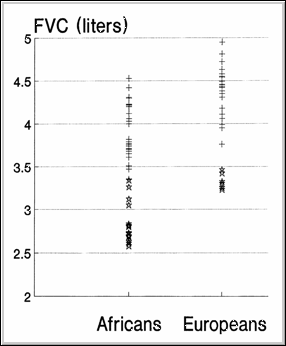 |
| Module 4: Physiology of the Respiratory System - Interpreting Spirometry. |
 |
| Module 4: Physiology of the Respiratory System - Interpreting Spirometry. |
When a spirometric test is being evaluated one of the steps is to compare the observed values for FEV1 and FVC with values that could be expected for that person.
The main determinant of lung function is body size and shape (primarily the ratio of leg and torso length). In adults lung function peaks at about age 25 and slowly declines thereafter (a process that may be accentuated by exposures and diseases). Height, gender and age are therefore the most important factors to consider when estimating expected or reference values for spirometry.
Numerous reference values are available for spirometry. Usually these values are expressed as equations, derived from multiple linear regression, stratified for gender, for example
FVC = Constant + (a x height) - (b x age)
Another important determinant of observed lung function in populations appears to be race or ethnicity. The reasons for this are not well understood. There are some circumstances (for example, population screening using spiromtery) where it may be important to take race into account when predicting lung function.
The "predicted value" is based on a reference population, and varies by gender, age, height and ethnicity.
 |
As illustrated in the figure on the left, numerous population studies of lung function have shown small, but potentially important differences between populations of different ethnic groups. The reasons for this are not well understood. If the context requires that population specific reference values be used, the following are recommended:
Men: Louw S, Goldin J. S.Afr.Med.J. 1996; 86: 814 - 815. |
Based on "percent predicted" and other considerations, spirometric tests can be interpreted and the severity of the abnormality classified.
For practical purposes an FEV1 or FVC > 80% predicted is considered to be normal.
An FEV1/FVC ratio > 70% is considered normal, although young adults should achieve > 75%.
Based on these cut-offs spirometric tests may be classified as normal or abnormal, however it is important to realise that such cut-offs represent an agreed on "rule-of-thumb" rather than an absolute division between health and disease.

Postgraduate Diploma in Occupational Health (DOH) - Modules 3 – 5: Occupational Medicine & Toxicology by Prof Rodney Ehrlich & Prof Mohamed Jeebhay is licensed under a Creative Commons Attribution-NonCommercial-ShareAlike 3.0 Unported License.
Permissions beyond the scope of this license may be available at http://www.healthedu.uct.ac.za/